
|   |

|   |
 e-mail: ukb7@rediffmail.com Parallel streams - creative and classical September 19, 2019 In the span of one month, two opposite polarities of ensemble dancing surfaced in the eastern metropolis. At one end, a group -- avowedly known for its contemporary credo -- threw the gauntlet into an open arena of creativity, to be picked up by any performative discipline. One can call it "collaboration" or "co-creation" or whatever one likes, the point made was to make the mantra of creative integrity and cut across borders of time and distance, and represent a global coherence of thoughts. In other words, they sought to celebrate the spirit of positive exchange and growth through a coming together of various artists and art forms, of tradition and contemporaneity, of individual and collective, of sensory and perceptive intelligence. At the other end was a well recognized body of corporate excellence, known for its running of successful whole night music and dance soirees for decades, now going for a clear amalgam of competitively chosen dancing talents and well established dancers --- all from the nationally demarcated classical genres --- with a judicious mix from Kolkata and outside, in a well honed three day format. It made interesting watching of both the polarities producing their own fascinating results. 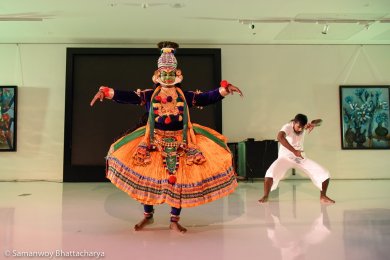 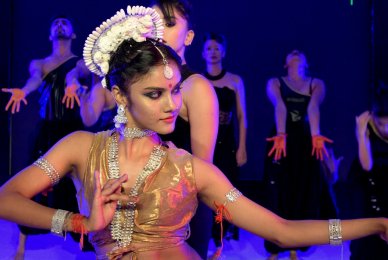 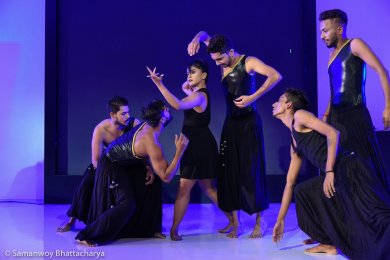 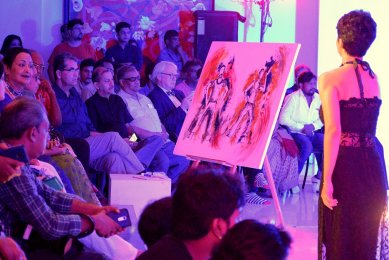 Sapphire Creations Dancing Strokes: Brushstrokes and Bodies Move in Rhythm presented on August 11 by Sapphire Creations, conceptualized by Sudarshan Chakravorty and Indranil Maitra, was designed to celebrate Sapphire's journey over twenty seven long and eventful years. As the audience walked in and settled down on the wooden steps of the beautiful indoor amphitheatre at Kolkata Centre of Creativity, they were greeted by a streaming video, Invisible Observers, created by Dibyendu Nath of Sapphire, where the dancers meander through alleys and by-lanes with dancing movements and marking a passage of time. They seamlessly spilled over into the performance of a threesome on the Centre's floor, engaged in an improvised set of solos, duets and trios almost marking their own journeys as dancers, their learning process and their inspirations. This was followed by other dancers joining in to traverse the floor space through various repeated body movements as if mapping the space out against time. Often, it seemed like creating the dance alphabet, with elements of touch and embrace, rise and fall, adoration and repulsion. Meanwhile, Koushik Das of Sapphire came with his Kathak repertoire with its flourishes, interweaving the younger dancers and engaging in an innately physical and free-wheeling narrative of movement. An improvised duet performance of guest Kathakali artiste Jadab Das and contemporary dancer Sylvester Mardi followed, with an Odissi dancer also sauntering in. The last segment was an excerpt from Sapphire's upcoming production Rasasutra, which saw different manifestations of beauty in the female body, questioning societal notions of beauty and what made one beautiful; how much of a woman's beauty lay in herself; and how much was in the sexual politics of the male gaze. Paramita Saha's depiction of an acid-burnt countenance was a disturbing reflection of what is happening in a warped society. The whole program was enlivened by Live Art showing Indranil Mitra vigorously painting away on his large canvas, the dancers' dynamic torsos. Festival of Indian Classical Dance Photos courtesy: Bhaskar Nandi Festival of Indian Classical Dance presented on September 6 to 8 by the redoubtable Dover Lane Music Conference and the Dover Lane Music Academy in Kolkata, was a sturdy annual. On day one, Anisha Parameswaran, the Bharatanatyam award-winner this year in Dover Lane's contest and a student of Mohana Iyer and Guru C.V. Chandrasekhar, opened the evening with a Ganesha invocation and Alarippu in raga Navarasa Kannada. She has imbibed Pandanallur style quite well, as was evidenced in the Tamil keertanam in raga Durga. Her talent really flourished in the padam by Subramanya Bharati in raga Kapi that described a khandita nayika having a tiff with Murugan. Abhinaya was composed by Kalanidhi Narayanan set in mishra chapu tala. Anisha concluded with a Tillana in raga Sumanesha Ranjini. 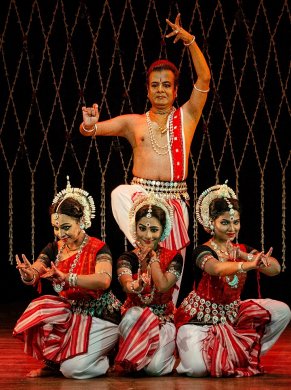 Rajib Bhattacharya & group 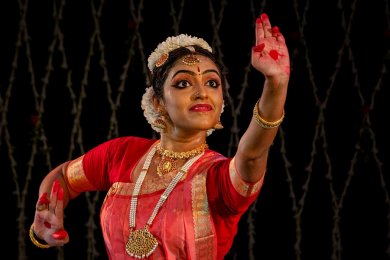 Anisha Parameswaran 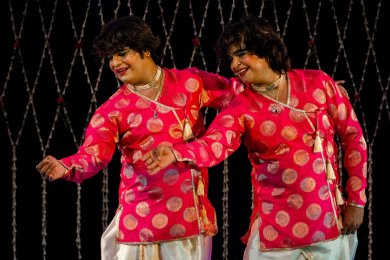 Sourav and Gourav Mishra Rajib Bhattacharya came next in Odissi. Groomed by Guru Kelucharan Mohapatra and now under the tutelage of Ratikant Mohapatra, Rajib also has a Masters degree in Odissi from Rabindra Bharati University. He opened with a Mangalacharan in raga Kedar, choreographed by Kelubabu. This was followed by a Bageshri Pallavi, choreographed by Ratikant Mohapatra with music by Raghunath Panigrahi, and executed by his well-trained group of six dancers. Rajib was majestic in a solo depicting Mahadeva Mahakaya... in ragamalika and talamalika. His excellent finale was Naba Durga, Jaya Bhagavati Devi Barade... in raga Bhairavi. Choreographed by Ratikant, this was executed by his group Srijan Chanda with six dancers. The last performance was the young Kathak duo, Sourav and Gourav Mishra of Benaras gharana. All of 25, the twin brothers followed the legendary Gopi Krishna's flashy style, donned heavy make-up and were largely lokadharmi. Having said that, their dancing talents - trained under guru Ravi Shankar Mishra, who accompanied them on padhant and also by Pt. Birju Maharaj, their maternal uncle -- were doubtless of very high order. Beginning with Ganapati Vandana, they executed with flourish, teentaal bandish by Guru Sitara Devi. They proceeded with technical Kathak: gat nikas, gat bhav, and several padhants, and concluded with an Ananda Tandava, singing themselves the lyric, Dimiki dimiki damaru baje, prem magana nache bhola... 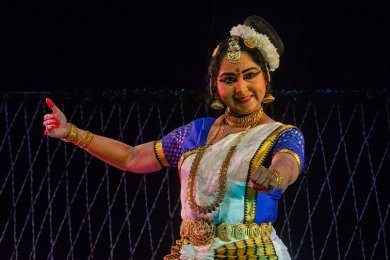 Gopika Varma 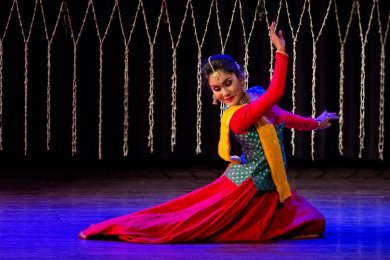 Srijita Baidya Gopika Varma, a senior Mohiniyattam dancer from Chennai - where she runs her own school Dasyam - was trained by the iconic guru Kalyani Kuttyamma and her daughter Sreedevi Rajan. Perhaps a little off color, she opened the second evening with a long dance-theatre Satyabhama Darpabhanga in a narrative style, using ragamalika and talamalika. The story was woven around the two principal queens of Krishna, Rukmini and Satyabhama, and their squabble over the divya pushpa Parijata. Krishna's gift of the divine flower to one creates intense jealousy in the other, leading to Krishna's clever ploy by planting the whole tree in one's garden, and letting its flowers fall into the other's compound! Gopika concluded by rendering ecstatically Adi Guru Shankaracharya's song, Bhaja Govindam, bhaja Govindam, Govindam bhaja, mudha matey..., set in the mellifluous raga Sindhubhairavi. Srijita Baidya, the young talent is a top award-winner in Kathak in the Dover Lane contest this year. Opening with a Shiva stuti Sundara Shiva Param Brahma..., she switched to teentaal in 16 beats and showed her considerable prowess in gat nikas and gat bhav. Changing to 14 beats, she demonstrated Maya Mrig parhant, Sawal Jawab with tihais and tatkar with layakari. Having learnt Kathak under guru Asimbandhu Bhattacharjee since the age of 5, this 19-year-old has blossomed well in her dance, but she needed guidance in her narration about her items on stage. She concluded with abhinaya to the well-known Dadra, Ranga sari gulabi chunariya re..., describing a mugdha nayika. 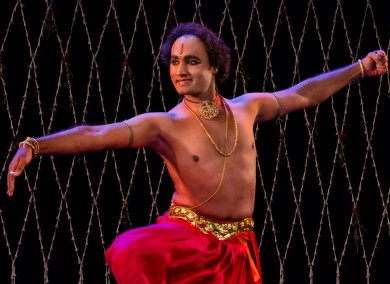 Gururaju 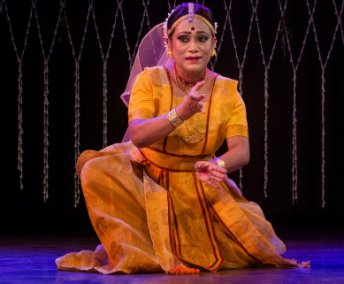 Anita Sharma Gururaju, the Bangalore-based Kuchipudi dancer, trained under Vyjayanthi Kashi, came next. His abundant energy and considerable skills made him stand out to be the best performer of the evening. He began with a Ganesha Vandana in raga Hamsadhwani and adi tala, composed by his guru. He then launched Ramayana Shabdam in raga Mohanam and adi tala, encapsulating the incidents from Rama's birth to his coronation, choreographed by his guru again, followed by Shivastuti in Ragamalika, narrating Shiva Tandava dance alongside Parvati on Mount Kailash, when Lakshmi sang, Indra played on flute, Vishnu was on mridangam, Saraswati on veena, and Brahma kept tala. Siva tandava, too, was composed by his guru. He concluded with a spectacular Tarangam, with refrains from Krishna Leela Tarangini in raga Mohanam making his stage entry on the brass plate from the distant wings and ambling back and forth on stage with consummate ease. The last dancer of the evening was Anita Sharma - groomed by the well-known Guru Jatin Goswami -- with her troupe of four dancers, offering Sattriya dance. She began with Krishna Vandana, Are jaya jagajivana Murari he..., composed by Bhaskar Jyoti Ojha, with four sakhis, that came through very well. This was followed by her long, expressive solo on another Krishna Stuti, Nishi pohaila prabhat haila... composed by saint Madhavadeva.  Asheemita Bagchi 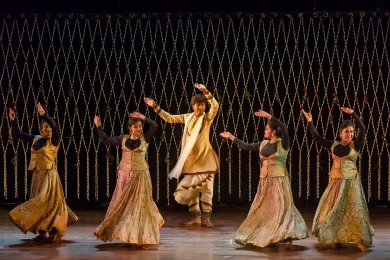 Sandip Mallick and group Asheemita Bagchi, the top award winner in Odissi dance in the Dover Lane Talent Search contest in the current year, opened the final evening with a Desh Pallavi. A student of Guru Kakali Bose for the last five years, she has been learning Odissi since the age of 6. Shaped up to be an excellent dancer, her Pallavi had lilting melody, sonorous rhythms and languorous movements, especially front-to-back undulations. The only other item she did was an ashtapadi from Gita Govinda, Rase Haririha bidhita vilambita... in raga Kalavati, depicting virahotkanthita nayika, leaving the viewers wishing for more. Sandip Mallick presented Kathak with his well-trained group of four male and eight female dancers. Sandip is a senior dancer with in-depth talim under many celebrated gurus like Pt. Birju Maharaj, Pt. Rammohan Misra, Pt. Chitresh Das and Pt. Vijay Shankar, besides Srilekha Mukherjee, Vandana Sen and Saswati Sen. He presented a composite Nrityakatha visualizing Nataraj Shiva and Natabar Krishna with two male dancers donning the supreme gods and the others playing around with many arresting patterns etched, and Sandip - with his majestic height - weaving beautifully in and out of the group, with multiple entries and exits. 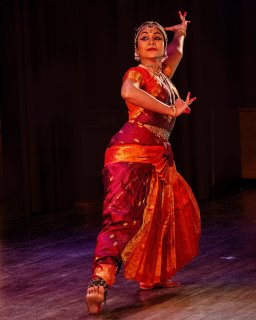 Kirti Ramgopal 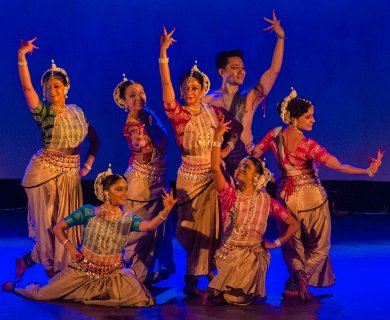 Sharmila Mukerjee and group Kirti Ramgopal trained under Padmini Ramachandran from a tender age and mentored and guided by Priyadarsini Govind, is an artiste of high caliber, with lively skill, geometric aptness and nimble felicity of grace. She began with Mallari with precise and distinct execution of pure dance and a delightful array of vibrant movements. She followed with Madhura Madhavam in raga Hindolam and adi tala, depicting Swaravarnam with vibrant expressions and exuding a rare spirit of joy. She concluded with a Gita Govinda ashtapadi, Sakhi hey kesi mathana mudaram... The delicate ecstasy of prathama samagama, the first conjugal union with Krishna, was quite well etched. Sharmila Mukerjee and her Bangalore based Sanjali ensemble came as the grand finale of the festival. Learning from Guru Kelucharan Mohapatra since 1984 at his residence in Cuttack and Bhubaneswar, Sharmila has been instrumental in teaching dance over the years both to Indian and foreign students. She began with a solo Mangalacharan in raag Hamsadhwani with music composition by Debashis Sarkar. Then came a group composition Visarini in raga Darbari, with music by Debashis Sarkar and rhythm composition by Satchidananda Das. Sharmila and dancers concluded the recital with a depiction of Shishira Geetam (winter season) from Kalidasa's Ritu Samhara, with music by Bijoy Jena and rhythm composition by Bijay Barikh. The ensemble members were Surojit Som, Srijita Sanjal, Suranjana Endow, Preeti Banerjee, Anushree Padmanabha and Kanika Mitra. All the three items were choreographed by Sharmila. With a somber visualization of winter in stark white costumes, the curtains came down.  Dr. Utpal K Banerjee is a scholar-commentator on performing arts over last four decades. He has authored 23 books on Indian art and culture, and 10 on Tagore studies. He served IGNCA as National Project Director, was a Tagore Research Scholar and is recipient of Padma Shri. Post your comments Please provide your name and email id when you use the Anonymous profile in the blog to post a comment. All appropriate comments posted with name & email id in the blog will also be featured in the site. |